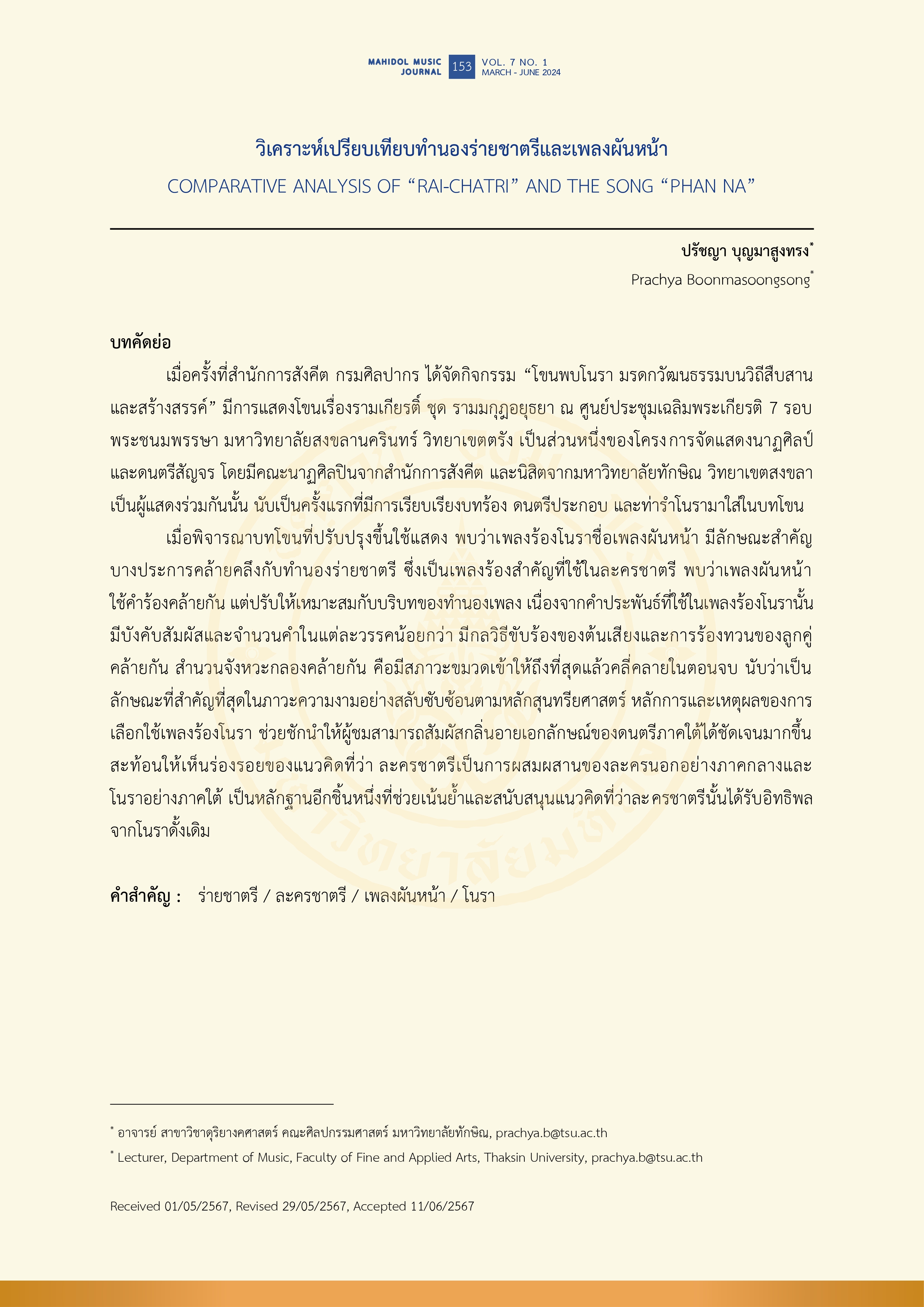COMPARATIVE ANALYSIS OF "RAI-CHATRI" AND THE SONG "PHAN NA"
Keywords:
Rai-Chatri, Lakhon Chatri, Pleng Phan Na, NoraAbstract
When the Office of Music, Fine Arts Department organized the activity "Khon Meets Nora, Cultural Heritage in the Way of Inheritance and Creativity," there was a Khon performance of the Ramayana, the Ramakuta Ayutthaya series, at the 7th Cycle Birthday Anniversary of His Majesty the King, Prince of Songkla University, Trang Campus, as part of the project. Exhibiting traveling performing arts and music with a troupe of dancers from the Sangkhi School and students from Thaksin University Songkhla Campus being a joint performer. It was the first time that the lyrics, musical accompaniment, and Nora dance moves were arranged into a pantomime.
When considering the improved pantomime script used for performing, it was found that the song Nora sang was called Pleng "Phan Na," it has some important characteristics similar to "Rai-Chatri." Which is an important song used in the Chatri drama. It was found that the song "Phan Na" uses similar lyrics but adjust it to suit the context of the melody. Because the words used in Nora's song forced touching and the number of words in each paragraph is less. There is a similar singing technique of the leading singing and the repeating singing of the choruses. There is a similar drum rhythm expressions in term of a state of being tensed to the utmost and then resolved at the end. It is considered to be the most important characteristic in the state of complex beauty according to aesthetic principles. Principles and reasons for choosing Nora songs helps lead the audience to experience the unique flavor of southern music more clearly. Reflects traces of the idea that Chatri drama is a combination of Lakhon Nok and Nora dramas from the south. This is another piece of evidence that reinforces and supports the idea that the Chatri drama was influenced by the original Nora.
References
Boonmasoongsong, Prachya. "The Analysis of Rai-Chatri in Rotthasen." Master's thesis, Chulalongkorn University, 2005. (in Thai)
Changsan, Teerawat. "Pran Nora." Master's thesis, Chulalongkorn University, 1995. (in Thai)
Damrong Rajanubhab, His Royal Highness Prince. Lakhon Fon Ram. Bangkok: Matichon, 2003. (in Thai)
Fine Arts Department. Drama Script: Ramayana Royal Writings of King Rama II. Bangkok: Thai Watana Panich, 1955. (in Thai)
Fine Arts Department. Drama Script: Rotthasen. Bangkok: Fine Arts Department, 1957. (in Thai)
Fine Arts Department. Gather Drama and Concert Scripts Written by His Royal Highness Princes Narisara Nuwattiwong. Bangkok: Sivaporn, 1963. (in Thai)
Fine Arts Department. "Khon Performance of The Ramayana, The Ramakuta Ayutthaya Series." Youtube Video, 3:18:28. August 23, 2023. https://www.youtube.com/watch?v=7vLThW1vQos.
Khramdang, Thanyanattakorn. "Khon Meets Nora, A Cultural Heritage based on A Way of Continuation and Creativity." Accessed April 20, 2024. https://www.finearts.go.th/performing/view/47041. (in Thai)
Rommayanan, Watchari. Evolution of Thai Literature. Bangkok: Textbook Project, Faculty of Arts, Chulalongkorn University, 1992. (in Thai)
Sumitra, Arada. "Lakhon Nai of The Royal Court in The Reign of King Rama II." Master's thesis, Chulalongkorn University, 1973. (in Thai)
Tramot, Montri. "Music and Singing Accompanying Drama and Dance Performances." In Art of Dance Drama or Thai Dance Textbook Manual, Arranged by Dhanit Yupho, 263-279. Bangkok: Sivaporn, 1973. (in Thai)
Tramot, Montri. Thai Amusement. Bangkok: Matichon, 1997. (in Thai)

Additional Files
Published
How to Cite
Issue
Section
License
Copyright (c) 2024 College of Music

This work is licensed under a Creative Commons Attribution-NonCommercial-NoDerivatives 4.0 International License.
The copyright of the article belongs to the author. Published articles represent the views of the authors. The editorial team neither necessarily agree with nor take any responsibility for the article.


